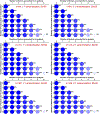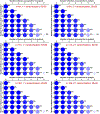Evaluating the impact of stratification on the power and cross-arm balance of randomized phase 2 clinical trials
- PMID: 39815460
- PMCID: PMC12143638
- DOI: 10.1177/17407745241304065
Evaluating the impact of stratification on the power and cross-arm balance of randomized phase 2 clinical trials
Abstract
Background/aimsRandomized clinical trials often use stratification to ensure balance between arms. Analysis of primary endpoints of these trials typically uses a "stratified analysis," in which analyses are performed separately in each subgroup defined by the stratification factors, and those separate analyses are weighted and combined. In the phase 3 setting, stratified analyses based on a small number of stratification factors can provide a small increase in power. The impact on power and type-1 error of stratification in the setting of smaller sample sizes as in randomized phase 2 trials has not been well characterized.MethodsWe performed computational studies to characterize the power and cross-arm balance of modestly sized clinical trials (less than 170 patients) with varying numbers of stratification factors (0-6), sample sizes, randomization ratios (1:1 vs 2:1), and randomization methods (dynamic balancing vs stratified block).ResultsWe found that the power of unstratified analyses was minimally impacted by the number of stratification factors used in randomization. Analyses stratified by 1-3 factors maintained power over 80%, while power dropped below 80% when four or more stratification factors were used. These trends held regardless of sample size, randomization ratio, and randomization method. For a given randomization ratio and sample size, increasing the number of factors used in randomization had an adverse impact on cross-arm balance. Stratified block randomization performed worse than dynamic balancing with respect to cross-arm balance when three or more stratification factors were used.ConclusionStratified analyses can decrease power in the setting of phase 2 trials when the number of patients in a stratification subgroup is small.
Keywords: Stratified randomization; block randomization; dynamic balancing; power; stratification; stratified analysis.
Conflict of interest statement
Declaration of conflicting interestsThe author(s) declared no potential conflicts of interest with respect to the research, authorship, and/or publication of this article.
Figures


Similar articles
-
Comparison of dynamic block randomization and minimization in randomized trials: a simulation study.Clin Trials. 2011 Feb;8(1):59-69. doi: 10.1177/1740774510391683. Clin Trials. 2011. PMID: 21335590 Free PMC article.
-
Safety and Efficacy of Imatinib for Hospitalized Adults with COVID-19: A structured summary of a study protocol for a randomised controlled trial.Trials. 2020 Oct 28;21(1):897. doi: 10.1186/s13063-020-04819-9. Trials. 2020. PMID: 33115543 Free PMC article.
-
Folic acid supplementation and malaria susceptibility and severity among people taking antifolate antimalarial drugs in endemic areas.Cochrane Database Syst Rev. 2022 Feb 1;2(2022):CD014217. doi: 10.1002/14651858.CD014217. Cochrane Database Syst Rev. 2022. PMID: 36321557 Free PMC article.
-
Consideration of stratification in confirmatory trials with time-to-event endpoint.Contemp Clin Trials. 2024 Jun;141:107434. doi: 10.1016/j.cct.2024.107434. Epub 2024 Jan 10. Contemp Clin Trials. 2024. PMID: 38215875
-
How to Balance Prognostic Factors in Controlled Phase II Trials: Stratified Permuted Block Randomization or Minimization? An Analysis of Clinical Trials in Digestive Oncology.Curr Oncol. 2024 Jun 17;31(6):3513-3528. doi: 10.3390/curroncol31060259. Curr Oncol. 2024. PMID: 38920742 Free PMC article.
References
-
- Latta RB. A Monte Carlo study of some two-sample rank tests with censored data. J Am Stat Assoc 1981; 76: 713–719.
-
- Kellerer AM and Chmelevsky D. Small-sample properties of censored-data rank tests. Biometrics 1983; 39: 675–682.
-
- Jones MP and Crowley J. A general class of nonparametric tests for survival analysis. Biometrics 1989; 45(1): 157–170. - PubMed
-
- Coart E, Bamps P, Quinaux E, et al. Minimization in randomized clinical trials. Stat Med 2023; 42: 5285–5311. - PubMed
MeSH terms
Grants and funding
LinkOut - more resources
Full Text Sources

